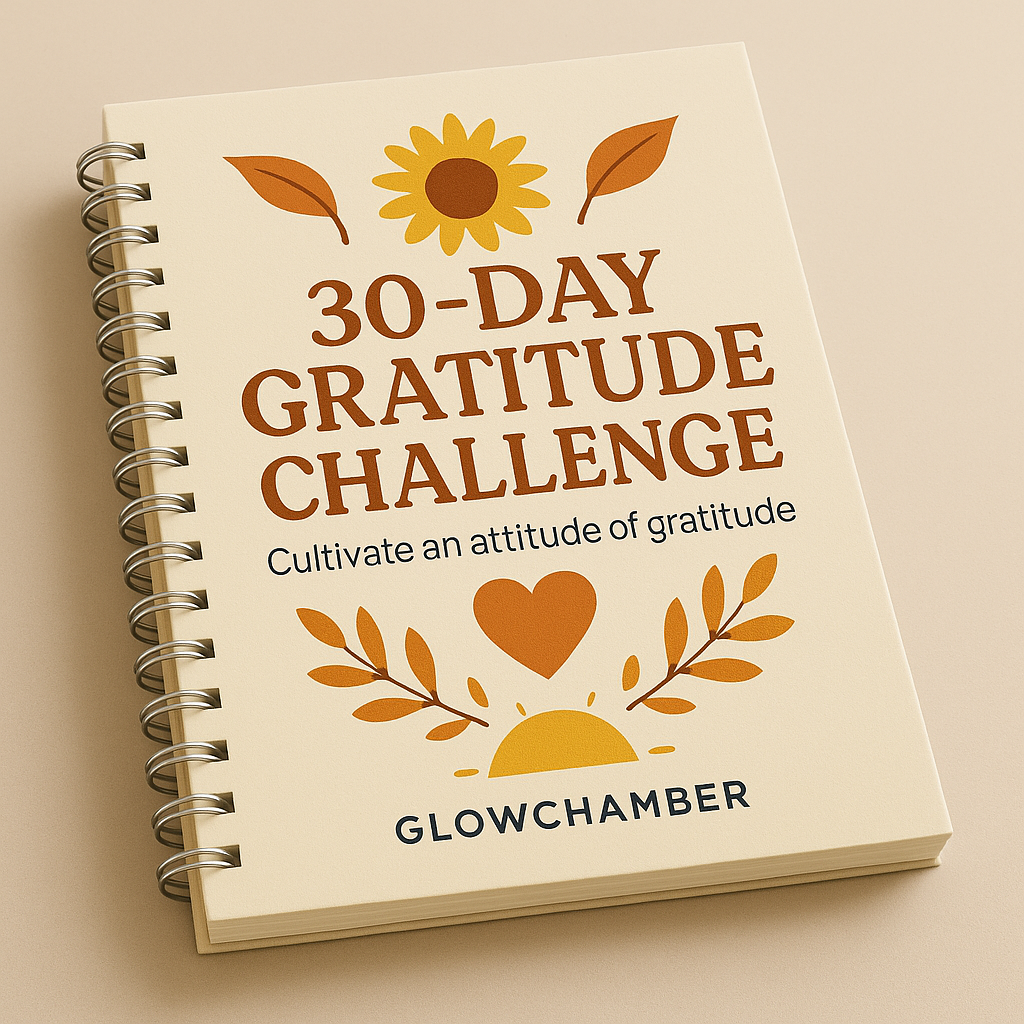Why Being Grateful Every Day Is the Most Powerful Self-Care Ritual
In a world that never stops spinning, gratefulness is the pause button we didn’t know we needed. It’s not just a feel-good word reserved for Thanksgiving captions or wellness quotes on Pinterest. Gratefulness is a transformative mindset, a grounding emotion, and a scientifically backed tool for building happiness, resilience, and inner peace. And in today’s high-speed, comparison-driven culture, it’s more essential than ever.
To help you begin your journey, download our 30-Day Gratefulness PDF Guide — a beautiful, printable resource designed to help you build your gratitude habit in just a few minutes a day.
What is gratefulness?
What Is Gratefulness?
Defining Gratefulness
Gratefulness, at its core, is the conscious recognition and appreciation of the good in our lives — both big and small. It’s different from a fleeting “thank you.” It’s a deeper awareness that acknowledges the value of experiences, people, and even challenges. From ancient Stoic wisdom to Buddhist teachings, the practice of gratitude has always been revered as a key to inner harmony. Religions across the globe, from Christianity to Hinduism, have long encouraged thankfulness as a virtue that aligns the soul with the divine.
The Psychology Behind Gratitude
How Gratitude Affects the Brain
Gratefulness activates powerful brain responses. When we express or feel gratitude, our brain releases dopamine and serotonin — neurotransmitters responsible for joy and contentment.
Neuroscience and Gratefulness
Neuroscientific studies have shown that practicing gratitude can literally rewire the brain. MRI scans reveal increased activity in the medial prefrontal cortex — the part of the brain associated with decision-making, empathy, and moral thinking.
Proven Benefits of Being Grateful
Emotional Benefits of Gratitude
Gratitude fosters emotional resilience by reducing feelings of envy, resentment, frustration, and regret. It helps shift focus from what’s lacking to what’s meaningful, creating a more balanced emotional state. People who practice gratitude regularly report fewer symptoms of depression and anxiety, leading to a more optimistic and emotionally grounded outlook.
Examples:
A busy professional keeps a gratitude journal and begins to feel less overwhelmed and more fulfilled by daily accomplishments.
After a breakup, someone reflects on the lessons learned and shared moments, easing emotional pain.
A parent under stress finds calm by focusing on small, joyful moments with their children, like bedtime stories or shared laughter.
Mental Health Benefits of Gratitude
Gratitude enhances cognitive function by improving focus, memory, and clarity. It reduces the mental clutter caused by stress and negative thinking, allowing for clearer problem-solving and decision-making.
Examples:
A student writes down three things they’re thankful for each night and notices reduced anxiety before exams.
An entrepreneur starts meetings with a moment of appreciation, which sharpens team focus and morale.
Someone with anxiety practices gratitude meditation and reports clearer thinking during stressful moments.
Physical Health Benefits of Gratitude
Gratitude contributes to physical well-being by lowering blood pressure, improving sleep, boosting immunity, and reducing inflammation. It also encourages healthier lifestyle habits.
Examples:
A person who reflects on positive moments before bed reports falling asleep faster and waking up more refreshed.
Post-surgery patients who practice gratitude show quicker recovery and fewer complications.
A fitness enthusiast motivated by gratitude maintains a consistent workout routine and healthy diet.
Social Benefits of Gratitude
Gratitude strengthens social bonds by enhancing empathy, trust, and cooperation. It makes people more likely to express kindness and support, creating positive social cycles.
Examples:
A team leader expresses thanks during a tough deadline, boosting group morale and collaboration.
A friend who consistently says “thank you” builds deeper and more lasting relationships.
A volunteer driven by gratitude regularly supports a local shelter, inspiring others to give back.
Gratitude and Success
Gratefulness in the Workplace
Gratitude in the workplace enhances motivation, job satisfaction, and overall productivity. Employees who feel appreciated are more engaged, more cooperative, and less likely to experience burnout. A culture of gratitude can transform the work environment into a more positive, high-performing space.
Examples:
An employee who receives recognition for their effort is more motivated to exceed expectations on future projects.
A team that regularly expresses appreciation reports higher morale and reduced turnover.
A customer service representative who feels valued is more likely to provide excellent service with a positive attitude.
Gratitude and Leadership
Leaders who consistently express gratitude build stronger, more innovative, and loyal teams. Far from being a soft skill, gratitude reinforces trust and drives performance by recognizing the value each person brings.
Examples:
A manager who thanks their staff in meetings encourages a culture of mutual respect and open communication.
A CEO who acknowledges behind-the-scenes efforts sees higher team engagement and commitment.
A project lead who sends a simple thank-you email after a milestone inspires continued collaboration and creativity.
Practicing Gratitude Daily
Simple Daily Gratitude Practices
ncorporating gratitude into daily routines doesn’t require major effort — just small, consistent actions. These simple practices help rewire your mindset, bringing more joy and presence into everyday life.
Examples:
Start a gratitude journal: each morning, write down three things you’re thankful for.
Whisper a quiet “thank you” during your coffee break — to the day, your body, or the moment itself.
Reflect at night on a moment that made you smile, no matter how small — like a kind text or a sunny walk.
Mindfulness and Gratitude
Blending mindfulness with gratitude deepens both practices. It grounds your awareness in the present and amplifies your appreciation for life's details.
Examples:
Take a slow, conscious breath and notice the rhythm of your body — be thankful for its strength and function.
Pause to feel the texture of your clothes or the warmth of your tea — gratitude lives in these small sensations.
Observe the colors, sounds, and flavors around you with curiosity and appreciation — turning ordinary moments into gifts.
Digital Detox and Being Present
Digital detox moments — away from the pressure of curated perfection — give you the space to reconnect with the present and your blessings.
Looking for an easy way to stay consistent? Download the 30-Day Gratefulness PDF Guide and build a sustainable gratitude habit step by step.
Scientific Studies on Gratitude
Landmark Research Findings
One of the most widely cited studies in the field was conducted by Dr. Robert Emmons (University of California, Davis) and Dr. Michael McCullough (University of Miami). In their experiment, participants were asked to write down a few sentences each week, focusing on either gratitude, irritations, or neutral life events.
Key outcomes included:
Those in the gratitude group reported significantly higher levels of optimism and well-being.
They exercised more frequently, indicating a positive behavioral spillover.
They also experienced fewer physical symptoms and reduced visits to the doctor, demonstrating that gratitude may directly affect physical health.
This study has since become foundational in the positive psychology movement, underscoring that what we focus on mentally can change how we feel and function physically.
Data-Driven Outcomes
Subsequent studies have expanded on this foundation with even more granular findings:
Examples from scientific research:
A study published in Applied Psychology: Health and Well-Being found that writing in a gratitude journal for just 15 minutes before bed can help individuals sleep better and longer — improving sleep quality by as much as 25%.
Research from the University of Pennsylvania revealed that practicing gratitude can boost happiness levels by 10%, which — according to psychologist Dr. Martin Seligman — is psychologically equivalent to doubling your income.
Functional MRI scans from neuroscience studies have shown that gratitude activates brain regions associated with dopamine release and social bonding, reinforcing the reward circuitry.
These results confirm that gratitude is not only a pleasant emotion, but also a powerful driver of measurable, positive change in both mind and body.
Gratitude in Adversity
How to Be Grateful in Tough Times
Gratitude during adversity isn’t about ignoring pain — it’s about shifting perspective. When life feels uncertain, unfair, or overwhelming, practicing gratitude can help anchor you in what remains steady, meaningful, or supportive. This practice builds emotional resilience, allowing individuals to process hardship without being consumed by it.
Even in the darkest seasons, gratitude doesn’t deny suffering — it reframes it. It highlights moments of strength, the kindness of others, or lessons hidden in hardship. Over time, this mindset fosters greater emotional endurance and mental clarity.
Real-Life Stories of Gratitude Through Pain
Real-world examples show how people find light, even in life's most difficult moments. Gratitude may not eliminate grief, illness, or trauma, but it provides a sense of grounding and growth — often becoming the thread that helps someone endure and rebuild.
Examples:
A woman undergoing chemotherapy expresses daily gratitude for supportive nurses, warm meals, and her body’s small victories — finding strength through the process.
A father grieving the loss of his child starts a nonprofit in their honor, grateful for the love he experienced and the lives he now touches through his advocacy.
After losing his job, a man begins to journal about the friends who check in, the extra time with family, and the chance to rediscover old passions — shifting from despair to renewal.
A trauma survivor shares that while the pain remains, focusing on the compassion they received during recovery helped restore their trust in humanity.
A refugee, forced to flee home, keeps a daily gratitude list about moments of safety, strangers who helped along the way, and a vision of rebuilding a new future.
These examples illustrate that gratitude isn’t a denial of hardship — it’s a path through it, offering meaning, connection, and healing even in the most difficult times.
Gratitude in Relationships
The Role of Appreciation in Healthy Relationships
A simple “I appreciate you” can deepen connection, resolve conflict, and reignite romance.
Expressing Gratitude Effectively
Whether it’s a partner, friend, or family member, expressing sincere appreciation builds trust and mutual respect. Gratitude makes people feel seen, heard, and valued — something we all crave.
Overcoming Barriers to Gratitude
Common Obstacles
Despite its benefits, gratitude isn’t always easy — especially during moments of stress, burnout, or self-doubt. Some days, gratefulness can feel distant or even disingenuous. Life’s noise, comparison culture, or emotional overload can cloud our ability to recognize the good.
Common hurdles include:
The comparison trap: Scrolling through social media can make others' lives seem more fulfilling, leading to feelings of inadequacy.
Overwhelm and burnout: When you're stretched thin, it’s hard to feel thankful — even for things you once enjoyed.
Negative self-talk: A harsh inner critic can make it difficult to appreciate personal progress or moments of joy.
Chronic stress or hardship: Prolonged difficulties can numb sensitivity to the small wins or daily kindnesses.
Recognizing these challenges is the first step toward creating a more compassionate, realistic gratitude practice.
How to Cultivate Gratitude Despite Challenges
Gratitude isn't about ignoring problems or faking positivity — it's about finding something steady amid the messiness of real life. Even when things are tough, gratitude can coexist with discomfort and uncertainty, offering perspective and peace.
Practical ways to stay grounded in gratitude:
Reframe one negative thought a day: Instead of “I didn’t get everything done,” try “I made meaningful progress today.”
Challenge your inner critic: When self-judgment surfaces, list three things you've handled well, no matter how small.
Use visual cues: Keep a sticky note, a photo, or a small token on your desk to remind you of something meaningful.
Practice “micro-gratitude”: Notice a hot shower, a kind word, or sunlight through the window — the smallest moments often hold the most weight.
Set a gratitude timer: Once a day, pause for 60 seconds to mentally list everything that’s helping you survive this season — not just thrive.
These tiny shifts can help make gratitude feel more accessible, even during life’s most difficult chapters.Tools and Apps for Gratitude Practice
Top Gratitude Journaling Apps
If journaling feels daunting, try apps like “Gratitude,” “Day One,” or “Reflectly.”
Digital Reminders and Alarms
Setting a phone alarm labeled “3 things I’m thankful for” can turn scrolling time into soul time.
Myths About Gratefulness
Common Misconceptions
Gratitude is often misunderstood. Some worry that practicing thankfulness means ignoring real problems, downplaying injustice, or becoming complacent. In reality, this belief stems from a myth that gratitude equals blind positivity.
Misconceptions include:
“Gratitude means settling.” People may fear that being thankful will dull their drive or ambition.
“You can’t be grateful and upset.” There's a false idea that gratitude requires constant happiness, even during hardship.
“It’s naive to be thankful in tough times.” Gratitude is often dismissed as unrealistic or ungrounded when things go wrong.
These misconceptions prevent people from fully embracing the nuanced power of gratitude — which isn’t about denial, but about perspective.
The Truth About Balanced Gratitude
True gratitude is not about ignoring problems — it’s about learning to see the whole picture. You can be grateful and still want change. You can pursue goals fiercely while appreciating where you are right now.
Examples of balanced gratitude in action:
An entrepreneur appreciates past milestones while pushing toward new growth.
A social activist stays thankful for community support, even while fighting for systemic change.
A student feels proud of their current progress and still aims for top performance.
A caregiver acknowledges the difficulty of their role while finding gratitude in small moments of connection or peace.
An employee voices concerns at work but also thanks their manager for listening and taking action.
Balanced gratitude creates resilience, not resignation — it helps people stay grounded while they continue striving.
Conclusion: A Grateful Life Is a Good Life
Gratefulness isn’t magic, but it might be the closest thing to it. It turns ordinary moments into sacred ones. It transforms mindsets from scarcity to abundance. And it reminds us that even when life isn’t perfect, it’s still profoundly beautiful.
Start your gratitude journey today with our 30-Day Gratefulness PDF Guide — a beautifully designed printable to help you turn thankfulness into a lasting habit. Click here to download and begin your transformation.
FAQs
1. How can I start practicing gratitude if I feel nothing to be thankful for?
Begin with the smallest things — the warmth of your bed, a deep breath, or the light streaming through your window. Gratefulness grows when we nurture it, especially on the hard days.
2. What’s the difference between being grateful and being complacent?
Gratitude is not complacency. It’s recognizing and valuing what you have, even while working toward something better.
3. Can gratitude help with serious mental health conditions?
Yes, while it's not a replacement for therapy or medication, gratitude has been shown to complement treatment for anxiety, depression, and PTSD.
4. How often should I practice gratitude for the best results?
Even a few minutes a day can make a difference. Consistency matters more than intensity.
5. Are there any risks to being "too grateful" or overly optimistic?
Overusing gratitude to bypass emotions (called toxic positivity) can be harmful. Balance gratitude with honesty and emotional authenticity.






